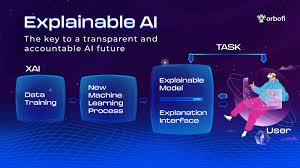As artificial intelligence (AI) systems continue to shape decision-making across critical sectors such as healthcare, finance, law enforcement, and hiring, the demand for transparency and trust has never been greater. Central to meeting this demand is explainable AI (XAI)—a branch of AI focused on developing models whose behavior can be understood and interpreted by humans.
Why Explainability Matters
Modern AI, particularly deep learning, has made remarkable strides in accuracy and efficiency. However, these gains often come at the cost of interpretability. Complex neural networks, while powerful, function as “black boxes,” making decisions that even their developers struggle to explain. This lack of clarity raises ethical concerns and erodes user trust, especially when the outcomes have real-world consequences.
Explainable AI addresses this issue by making AI systems more understandable without compromising performance. The goal is not only to make AI more transparent but to ensure that humans can question, audit, and validate AI-driven decisions.
The Role of Transparent Algorithms
At the heart of AI interpretability are transparent algorithms—models designed with simplicity and clarity in mind. Unlike black-box models, transparent algorithms allow stakeholders to trace how input data leads to specific outputs. This traceability is crucial in regulated industries, where decisions must be justified and held to standards of fairness and accountability.
For example, in healthcare, a transparent diagnostic model can explain why a particular treatment is recommended, allowing doctors to make informed decisions and patients to understand their options. In finance, it can clarify why a loan application was approved or denied, helping institutions comply with anti-discrimination laws.
Balancing Accuracy and Interpretability
One of the challenges in promoting AI interpretability is finding the right balance between model complexity and transparency. Simpler models such as decision trees and linear regressions are inherently interpretable but may not perform as well on complex tasks. On the other hand, high-performing models like deep neural networks often lack inherent explainability.
Researchers and developers are working on hybrid approaches—models that retain performance while offering post-hoc explanations. Techniques such as LIME (Local Interpretable Model-agnostic Explanations), SHAP (SHapley Additive exPlanations), and attention mechanisms provide insight into how complex models make decisions without modifying the models themselves.
Building Trust Through Explainability
Ultimately, explainable AI is more than a technical goal; it is a foundation for ethical AI development. By incorporating transparent algorithms and improving AI interpretability, organizations can foster trust among users, regulators, and society at large.
Explainability enables users to feel confident in AI systems, knowing that decisions are not arbitrary and can be justified. It also empowers developers and stakeholders to identify biases, correct errors, and ensure alignment with human values.
Conclusion
As AI systems become more integrated into everyday life, the call for transparency and accountability grows louder. Explainable AI offers a clear path forward by bridging the gap between advanced machine learning capabilities and human understanding. With the adoption of transparent algorithms and a commitment to AI interpretability, we can build systems that not only perform well but also earn our trust.







